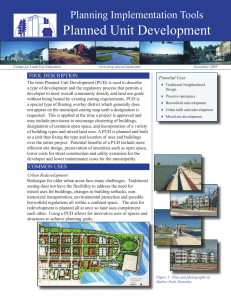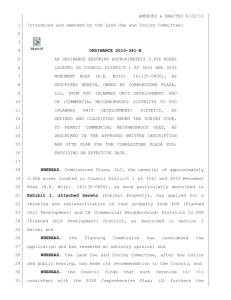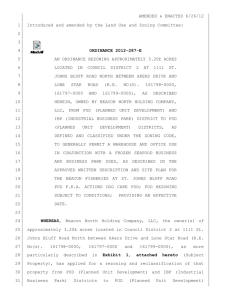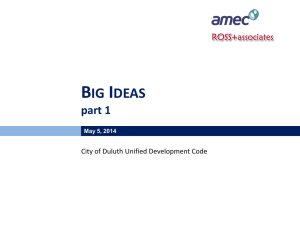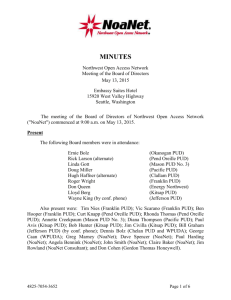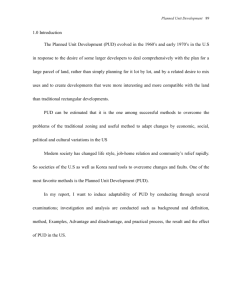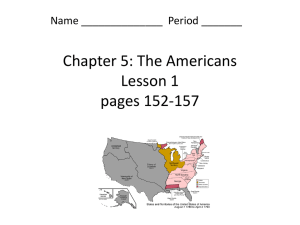Law Lecture 18 - Planned Unit Developments
advertisement
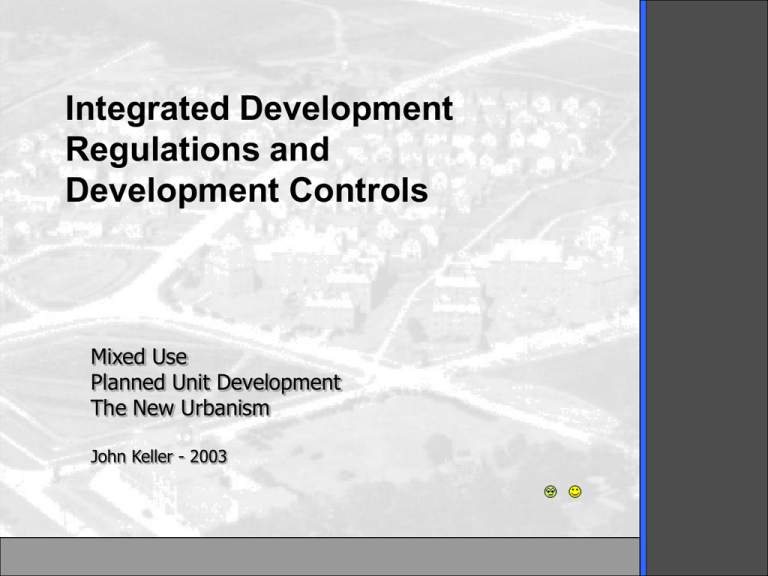
Integrated Development Regulations and Development Controls Mixed Use Planned Unit Development The New Urbanism John Keller - 2003 From A One Trick Pony To Planning With Sophistication •PUD is an integrated, mixed use approach to physical development •A tract is planned as a whole, scaled into different units or villages, and granted flexible design capability to achieve a more common sense approach to development •The PUD is an overlay zone Genesis of the PUD Hallmarks •The hallmark of the PUD is that the overall development density remains the same as in neighboring area but it is arranged so as to maximum common open space • • • • • • • • Mix of integrated uses Maximum ratio of each use to the entire development Common open space and OSR Innovative space design and FAR Concentration of infrastructure Homeowners’ association Phasing Designed as an integrative whole Typical Plan Open Space Retention Integrated Open Spaces Village Design Plan Cheney v Village II at New Hope Legal Test of the First PUD Ordinance •In December of 1964 borough council began considering the passage of a new zoning ordinance to establish a PUD district in New Hope. •Council consulted with members of the Bucks County Planning Commission on the text of the proposed ordinance, held public hearings, and finally on June 14, 1965 enacted ordinance 160 which created the PUD district •They amended the borough zoning map, rezoning a large tract of land known as the Rauch farm from low density residential to PUD. B A C K G R O U N D The Ordinance • The Ordinance Permits – – – – – – – Maximum of 80% residential Maximum of 20 percent commercial/office Minimum of 20% open space Residential density max. is 10 d.u./acre No traditional yard or setback requirements Structures must maintain 24’ separation No townhouse may contain more then 24 units Phases, Villages and Development Plan at Village @ New Hope I II and III The Developer • The Rauch Development Company applied for a medium density PUD with mixed retail commercial uses • Neighboring residents appeal to BZA and then brought a law suit • The trial court reverses the board, holding the ordinance invalid for failure to conform to a comprehensive plan and for vesting too much discretion in the New Hope Planning Commission The Appeal • Did The Borough Abuse Its Authority – The PUD district had been under consideration by council for over six months – And had been specifically recommended by the borough planning commission, a body specially equipped to view proposed ordinances as they relate to the rest of the community – The court held that the board, within its sound discretion, could have concluded that council passed the ordinances with the proper overall considerations in mind. The Spot Zone Question • Is A PUD (Overlay Zone) Spot Zoning – A PUD is a floating zone, but it is brought to earth by a specific ordinance upon application of the developer. – A PUD does allow development standards that are different than traditional zoning districts “but we think that the well reasoned discretion of the Borough is not abused by allowing innovative planning” Ultra Vires Argument • There Is No Authority For Creating A PUD under Pennsylvania Legislative Authority – One of the most attractive features of Planned Unit Development is its flexibility – The chance for the builder and the municipality to sit down together and tailor a development to meet the specific needs of the community and the requirements of the land on which it is to be built – This would be lost if the Legislature required exacting standards before any developer could happen upon the scene to tailor a specific agreement that meets the community’s needs. Conclusion • PUD is not an abusive of authority • Exact standards are not required – only maximum and minimum guidelines are needed • Although the PUD is not specifically authorized by planning legislation, it is clear that the power lies well within the power of the local community Rudderow v Mt. Laurel N.J • This is an early case (1972) testing the due process of the PUD process • Mt Laurel carefully crafted a PUD ordinance and it was based on the New Jersey enabling legislation authorizing the PUD form of land development regulation • In 1969 a developer made a PUD application for a 5 villages, 162 acre project - with 972 low and medium d.u’s for garden apartments, townhouses, and mid rise multifamily – a regional shopping center - lakes – recreation and a community building: known as Cross Keys The Master Plan Village 3 Recreation Village 2 Village 1 Village 5 Village 4 Open Space Regional Shopping Center The Storm Brews The Planning Commission holds 5 separate hearings to review the Planned Unit and receive public input. It was bitter and divisive The Previews • After 5 hearings the township gave preliminary approval for Cross Keys • Residents sued and the trial court set aside the tentative approval • The trial court's conclusion was that "the ordinance is invalid in that it does not provide for specific districts as required by the statutes and Constitution of this State.“ • The court also found that the regional shopping center is invalid because it goes beyond what is necessary to serve the village’s residents The Main Feature • The trial court also invalidated the PUD on two additional findings – There was a slight miscalculation in determining the maximum area that could be used for commercial – The minimum open space calculation was less (slightly) than contemplate by the general PUD ordinance for Mt. Laurel – In other words, I don’t think the trial court liked anything about the PUD concept Appeal - N.J. Supreme Court • Is PUD Authorized – Do You Need Specific Zones? – The obvious advantage emanating from the use of P.U.D. is its flexibility in enabling a municipality to solve some of its existing zoning problems, and meet its future community needs with the land remaining for development – To require P.U.D. ordinances to establish specific districts wherein a P.U.D. may be authorized, would destroy the very purpose and philosophy for its creation. Serving Specific Needs • Can You Only Build Commercial to Serve the PUD Residents? – Again, we find the trial court took too narrow a view of the enabling statute. Such construction by the trial court would continue existing, and create additional, "Euclidean" zoning problems and nullify the legislative intent. – We construe the statute to authorize municipalities, where warranted, to permit commercial uses in a P.U.D. project beyond that needed for the residents within the planned community. – Municipalities, as part of their comprehensive zoning plans, may properly anticipate and provide for the present needs of the public now residing in the areas surrounding the planned community, as well as the reasonably foreseeable future needs of the public they anticipate will move into the area and require servicing. Miscalculation of Space & Standards • • • • The miscalculation of acreage designed for commercial use is too insignificant to affect the legality and adequacy of the ordinance Found that the ordinance adequately meets the requirements on designation of required open spaces. It is obvious that the Legislature gave municipalities the right to determine the extent of open space deemed desirable and necessary. There is ample support in the record for the township's finding of fact that the open spaces designated in "Cross Keys" were adequate and reasonable. Award Winning Picture De Jure Lutz v City of Longview WA • The time frame is 1973 • The developer purchases a 4 ½ tract acre and files a PUD for 2 a building development with with 28 d.u.’s • The tract was zoned low density R-1 • Under the Longview ordinance, the city delegated to the planning commission the authority to approve an application for a PUD in the municipality The ordinance contains no provision whereby the city council is required to approve or review the decision of the planning commission • • After a public hearing by the planning commission, the PUD was approved. So, What’s The Big Deal? • The major issue is whether the city council had the authority to delegate to the planning commission final approval of a planned unit development which thereby affixed the concept to a specific tract • Its clear that the Planning Commission, in most states, is given the total power to approve physical development – but not the rezoning • Does not the PUD as a floating zone involve a rezoning and thus the adoption of an ordinance? Appeals Court Analysis • The PUD achieves flexibility by permitting specific modifications of the customary zoning standards as applied to a particular parcel • The developer is not given carte blanche authority to make any use which would be permitted under traditional zoning • Under the Longview ordinance the PUD is not affixed, at the outset, to any particular area • Therefore, this device is a floating zone. It hovers over the entire municipality until subsequent action causes it to embrace an identified area Findings • • • • • What is the legal nature and effect of the act of imposing a PUD upon a specific parcel of land? Court holds that it is an act of rezoning which must be done by the city council because the council's zoning power comes from the statute and that is what the statute requires It is inescapable that application of the PUD to this tract constituted an act of rezoning Before the PUD was authorized, the tract here was limited to low density single family residences primarily After authorization of the PUD the permitted use is the erection of two large buildings – – One of them 55 feet high, consisting of 28 living units, containing 46,900 square feet The change in permitted use is obvious. Conclusion of Law • All amendments, modifications or alterations to the comprehensive plan are determined in the same fashion • Only the legislative body is empowered to adopt a zoning map and ordinance. Obviously the state has vested the authority to zone and rezone solely in the city council • The City Council has no authority to delegate this power • Christians zero– Lions one One Last Point – Spot Zoning Again • The trial court said that the PUD actually constituted spot zoning – This contention is without merit. Spot zoning has come to mean arbitrary and unreasonable zoning action by which a smaller area is singled out of a larger area or district and specially zoned for a use classification totally different from and inconsistent with the classification of surrounding land, and not in accordance with the comprehensive plan. Form Based Zoning
